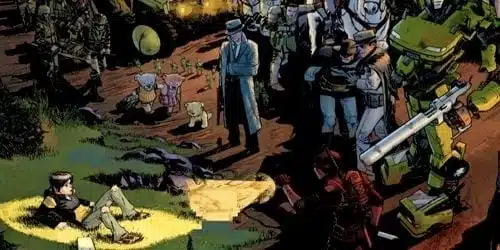
Joe the Barbarian, the psychologically engaging limited series written by Grant Morrison with art by Sean Murphy, is a tale of fractured geographies. This magical realist tale of a boy confronting the destruction of his Playtown, is littered with the exchange of locations both ‘real’ and ‘imagined’ in the fictional work presented to readers. For early teen protagonist Joe, each location bleeds into the next. Playtown itself becomes as substantial and fully fleshed-out a series of locations as Joe’s ‘reality’ of home, family and school. But Morrison and Murphy to do not offer up a congenial transition from one world to the next, as with J. K. Rowling’s Harry Potter series or C. S. Lewis’ Narnia books. For Joe, both his homeworld and Playtown are geographies in a state of severe rupture. Joe’s two worlds are about to be destroyed, rejuvenated, reconstituted, merged, unveiled. Nothing is safe and wonder is everywhere. Joe the Barbarian plays out in a psychological time period before Columbine, before roles have properly been determined and teens become actors on a stage of sadly foreseeable consequences.
Murphy writes in “On the Ledge”, the weekly Vertigo editorial, about his personal sense of immersion in Joe’s world, and his wanting to add ’70s and ’80s accents (accents from Murphy’s own childhood) into the visual mix. Murphy writes: ‘A fantasy that’s Lord of the Rings meets Home Alone. My favorite part of the first issue is the interior of Joe’s house: dated ’70s furniture, faux wood paneling on the walls, and shag carpeting. Instead of modern toys like a PS3 and Xbox, Joe owns an Atari and a Nintendo. All his toys are classic ’80s action figures that each one of us grew up with. There’s even an electric train circling his bedroom’.
As a visual storyteller, Murphy recognizes the core of Joe the Barbarian: its ability to convey psychology through setting. Joe the Barbarian is of the same genre as the classic ‘haunted house’ mystery. What is interesting about the characters themselves is their guarded, jaded, poignant responses to their environment. Will Joe balk at having to confront his own Playtown’s destruction? Will he willingly take up the challenge in defending it? Or join in an adult life and simply destroy his childhood world?
Morrison’s characterization is a clear and uncompromising grappling with an issue that hits at the heart of the modern comics market — the role and value of an imaginative inner life in the transition from childhood to adulthood. ‘Of what practical use can a Playtown be?’, Morrison seems to ask. The question is perhaps no different than what the role of comics purchases should be in an adult life.
Like comics aficionados, Morrison argues passionately for the innate value of an imaginative life. In an almost throwaway comment early in the issue, Joe recognizes both his bullies, and himself as stereotypes. ‘They’re just jealous and insecure’, a friendly character says of Joe’s bullies. To which Joe retorts, ‘More like predictable. Every town has them, every school has them. Stereotypes. What do I look like?’.
Morrison’s incredible skill as storyteller (Murphy’s use, in “On the Ledge” of the epithet ‘master’ when discussing Morrison is truly well-deserved), becomes abundantly clear with his ability to connect Joe’s worlds. Joe’s incisive nature comes from his approach to shaping the world of Playtown. Joe’s toys do not take the form of a preparation for adult life (dolls and Easy Bake ovens for girls who become mothers, toy soldiers and medical kits for boys who become soldiers and doctors, as Roland Barthes argues in his book Mythologies), instead they play a far more positive role. In Joe’s inner world, his toys become the tools of storytelling. Moreover Joe himself becomes a demiurge, continually tapping a creative spirit that becomes central to his psychological development.
Priced at just $1.00, DC Vertigo taps into that creativity that stems from easy access to psychological complexity. The joy and the danger of childhood, resurrected by an elegant marketing strategy. Joe the Barbarian comes with an incredibly high recommendation, and equally high expectations of the seven issues remaining in the series. This is a book that deserves to be read.
